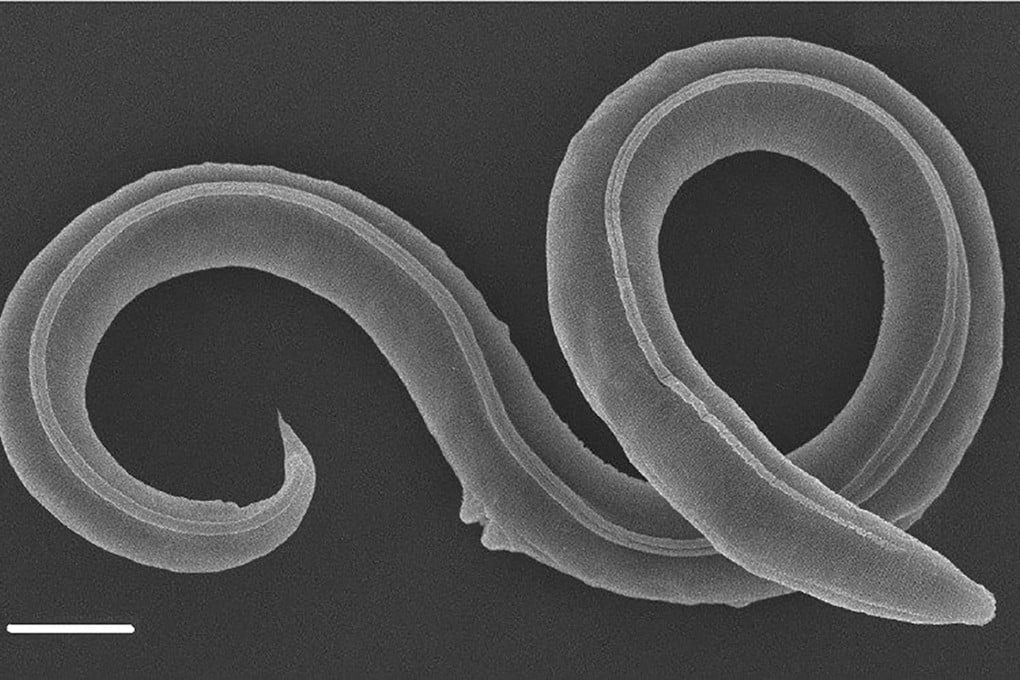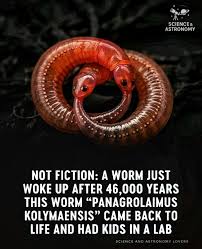Table of Contents
Introduction to the discovery of a worm after 46000 years
What might it be like to discover an animal that has been asleep for a mind boggling 46,000 years? And it might just as well fit the appeal to a science-fiction film, I suppose. It is not fiction, however. Recently, scientists have reanimated a worm on Panagrolaimus kolymaensis identified in Siberian permafrost. Such a brilliant find prompts interesting questions on resistance and being able to stay alive in such an environment. What mysteries is this old organism hiding? And what would the revival of it mean to our concept of life on this planet? So strap in because we are gonna enter into the crazy world of this little titan and see what consequences its amazing time travel has.
The species of the worm – Panagrolaimus kolymaensis

Here is Panagrolaimus kolymaensis, a nematode worm that has been grabbing the heads of scientists across the globe. This is a spectacular life for it was found in permafrost close to Siberia and it provides answers to how life could be so resilient.
The thing is that P. kolymaensis is very long-lived. It can live 46,000 years under ice and soil layers, thus reconciling our knowledge of the boundaries of life.
These micro-organisms survive in the harshest of conditions where other forms of life cannot survive. Their capacity to pass into a cryptobiosis (suspension of animation) enables them to bear cold temperatures and low oxygen concentration.
What interests the researchers is that these worms comfortably survive eons without food or locomotion on a cellular level. These secrets in their small bodies could provide solutions on durability in extreme conditions not only to worms but also to other species as well because of the genetic information of these worms.
P. kolymaensis opens the windows into the world of the amazing potentialities and adaptability of life on earth and beyond.
How did the worm survive for so long?
The beautiful thing is that the Panagrolaimus kolymaensis has faced a tremendous 46,000 years in the wild and this speaks highly of the sheer survival of nature. This is a microscopic worm that was adapted to live in the harsh land of Siberia in the frozen tundra.
Its secret depends on cryptobiosis which is a condition when organisms can put their metabolisms on hold. Basically, the worm went into a hibernating process through which it was able to survive in the state of extreme desiccation and freeze without dying.
In this dormant condition, its cells are not destroyed but metabolic activities are put at a stalemate. They are able to survive within the radiation and other toxic environments which would otherwise kill them.
This strikingly amazing adaptation poses questions on the preservation of life even in an adverse condition. Discovering such processes may open a new door to answering the question of the possibility to live beyond the boundaries of our planet or even to the survival of the endangered species.
Similar cases of organisms surviving extreme conditions
Mother nature is not predictable, especially in terms of resilience. Some creatures have evolved to resist extreme conditions which will kill most forms of life.
Tardigrades commonly called water bears, are tiny organisms having remarkable ability to survive. They also survive extreme temperatures that extend to absolute 0, and more than 300 degrees Fahrenheit. They not only survive radiation but even the vacuum of space.
Likewise, there are other bacteria that have been identified to survive in the crushing depths of the deep sea hydrothermal vents whose temperatures are very high. These are extremophiles that grow where there is no sunlight and oxygen.
The other interesting example is the Antarctic krill that has found ways to live in the frozen waters and still succeeded in sustaining a rich ecosystem around it. Their flexibility demonstrates the persistence of life through all odds.
These exceptional cases display how adventurous life may be and they question our perception of the boundaries of life.
Potential implications for science and research
The find of Panagrolaimus kolymaensis is the door to a new scientific discovery. Resistance of life demonstrated by this ancient worm to extreme conditions questions our knowledge about life resilience.
Scientists could investigate its biosystem, and this could explain how people live so long and survive. Lessons learned may transform such sciences as cryobiology or extremophile studies.
Moreover, those discoveries induce speculations regarding the boundaries of existence on Earth and perhaps in space. Are other extreme environments possible to harbor similar organisms?
This has the potential of influencing the direction of astrobiological studies as we seek extraterrestrial life. The consequences spread even into biotechnology that is proving to be innovative in terms of medicine and storage.
Maybe we will discover some of the secrets as the scientists pursue the search of these tough organisms further, and we will not only know more about evolution but also change the concept of being alive under extreme conditions.
Ethical considerations
The ethical issues involved in rousing a worm after a 46, 000-year slumber are very serious. What are the rights of an organism which has laid dormant for thousands of years?
There are ethical issues of creating life forms that have died out long ago. Should we be messing with nature that is long overdue to take its own path? One can discuss the possible danger to the current ecosystems.
Besides, there is genetic unity. Such manipulation may have undesirable environmental and ethical results. There is a great caveat to the researchers.
Another issue that comes about with reintroduction of such animals is the issue of conservation of biodiversity. Should we concentrate on the extinct ones as opposed to the ones we have today and which are endangered? It is highly essential in this fascinating quest to locate the middle ground between scientific fascination and accountability.
The enthusiasm of the moment of the discovery of new species such as Panagrolaimus kolymaensis must not have the chance to prevail over the sense of being good stewards and responsible caretakers of life on this planet.
Conclusion
Even the finding of an awakened 46,000 years old worm Panagrolaimus kolymaensis one can question our visions of life and resilience. This fascinating discovery intrigues the imagination as well as invites new paths in the way scientific research is developed.
Discovering the way such organisms can live in the extreme conditions we might learn some secrets of life adaptability. The implications are not limited to the issue of curiosity, but may change our perception of conservation efforts and, possibly, even of the search for extraterrestrial life.
These discoveries however have brought with them ethical issues. We should be cautious when we investigate ancient ecosystems and deal with the risk and possible advantages.
Such a spontaneous awakening helps to remember about the secrets of nature that can be discovered. It reminds us that we still have so much more to figure out in this large world around us-where truth can at times be crazier than fiction.
